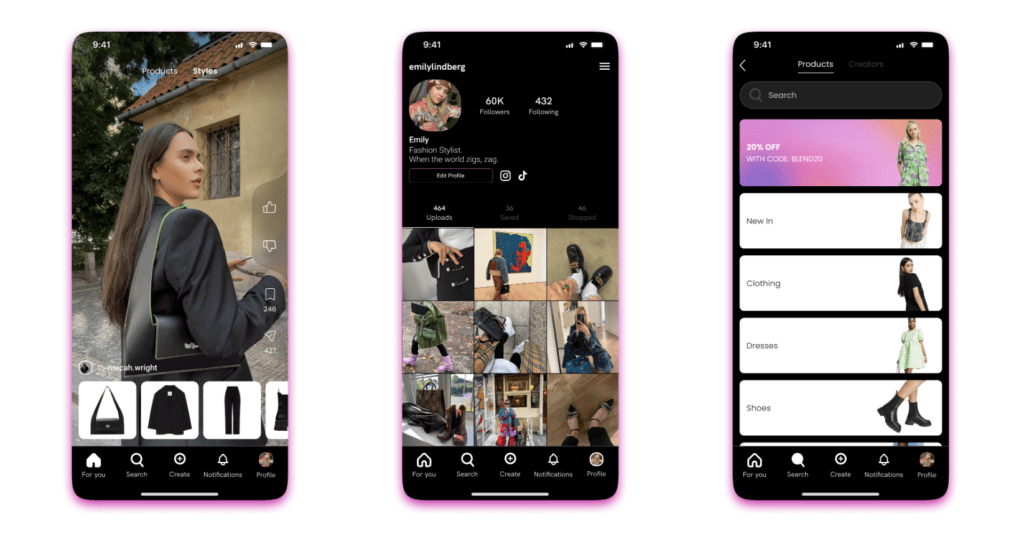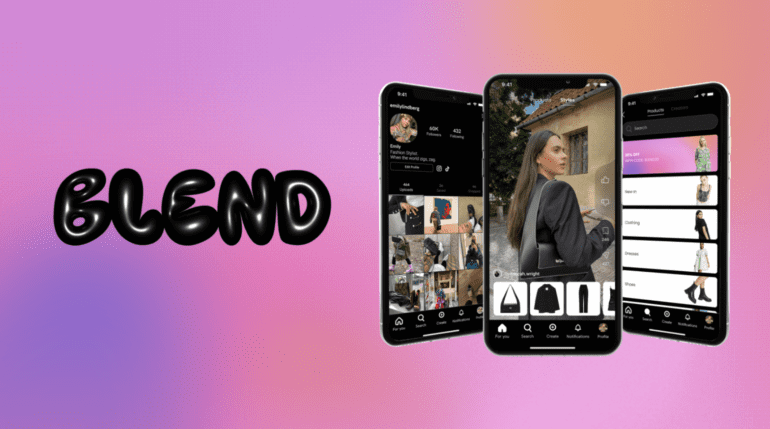TL;DR:
- Blend, a UK-based startup, leverages generative AI to offer personalized clothing recommendations.
- It addresses the challenge of overwhelming online fashion choices.
- Blend’s MVP app recently launched after securing angel investment and aims to expand further.
- The startup collaborates with over 250 retailers, targeting users aged 18 to 34.
- Their approach centers on transformer technology, offering dynamic and evolving style recommendations.
- Blend also helps users find the right fit through user-generated content.
- Their business model involves shoppers, influencers, and brands, providing mutual benefits.
- Blend generates revenue by taking a commission on sales from partner brands and retailers.
- Future plans include in-app purchases and exploring a subscription service.
Main AI News:
In the age of e-commerce, shopping for clothing has undergone a radical transformation. No longer do we need to navigate the labyrinthine aisles, harsh fluorescent lights, and the frenzy of sale-seeking crowds in physical stores. However, the digital realm presents its own challenges. Many of us have found ourselves lost in a virtual fashion maze, drowning in open tabs, loaded shopping carts, endless YouTube clothing reviews, and the persistent feeling of being overwhelmed. The convenience of online shopping often comes at the cost of a daunting shopping experience.
Enter Blend, a UK-based startup revolutionizing online shopping through the power of AI. Blend leverages generative AI to provide personalized product recommendations that cater to an individual’s unique style, budget, and size, aiming to streamline the online shopping process.
Traditional retail behemoths often fall short when it comes to personalization, relying solely on historical purchase data to make recommendations. However, in a world where fashion trends shift rapidly and personal styles evolve, historical data can quickly become obsolete. Blend recognizes this gap and seeks to fill it.
Recently showcased at TechCrunch Disrupt 2023 as part of the Startup Battlefield 200, Blend introduced its Minimum Viable Product (MVP) – an app that will gradually become available to the 2,000 users on Blend’s waiting list. Following a successful angel investment round in April, Blend is now on the lookout for investors to fund its next phase of development and a full-scale launch.
What sets Blend apart is its collaboration with over 250 retailers, including luxury giant Net-a-Porter. The startup’s strategy is laser-focused on users aged 18 to 34, tech-savvy individuals who are beginning to define their personal style as they accumulate disposable income. Blend will first launch in the UK and then set its sights on the US market.
Jemima Bunbury, co-founder of Blend, explains their vision, “We hope that by attracting first the very fashion-forward, trendsetting crowd, we can then move more mainstream from there, but it’s much more difficult to go the other way round. Ultimately, the vision is really to be the front door for every online shopping experience and, therefore, to be the largest-scale retailer because of that ability to personalize and only present people with the 1% of the internet that is most relevant to them.“
The fashion industry has embraced generative AI across various facets, from enhancing customer service with natural language processing algorithms to creating new designs using image generation. Blend’s approach centers around transformer technology and recommendation algorithms, heavily reliant on user interaction data. This technology, akin to models like ChatGPT, enables the platform to better grasp user preferences and offer tailored clothing suggestions.
Crucial to AI’s effectiveness is the quality of the data fed into it. Blend’s decision to develop an app rather than a web page is driven by the ease of tracking user data. When users access the app, they encounter a dynamic feed featuring product imagery, descriptions sourced from various retail and e-commerce sites, short-form videos, and product curations by influencers who can earn commissions on generated sales.
As users engage with the app, Blend collects data on their interactions, such as product likes, saves, shares, and even the time spent perusing a particular item. This data amalgamates to create a user profile, taking into account pre-set size and budget preferences. The more a user engages with the app, the more finely-tuned and personalized their recommendations become.
Behind the scenes, Blend employs a comparative analysis of products and users to build a statistical framework. For instance, if two users actively engaged with the app three months ago, but one user’s engagement waned while the other continued to interact regularly, Blend won’t let the first user’s recommendations stagnate. Instead, it will draw from the second user’s data to inform recommendations for the first, thus continually enhancing personalization.
What distinguishes Blend further is its AI’s ability to predict not just today’s outfit but tomorrow’s, next week’s, and even next year’s. It evolves with a user’s changing style over time.
Moreover, Blend aids users in finding the right fit for their body type, a boon for retailers plagued by costly return cycles. Users can set preferences for size across different body parts and classify their body type. However, the challenge lies in the reliability of such information, given that brand sizing charts often vary widely, and self-classification can be subjective. Blend encourages user-generated content, encouraging users to post photos of themselves in their new outfits, providing the AI engine and fellow users with a diverse range of body types to gauge how specific products suit different frames. In the future, Blend plans to incorporate reviews and a voting system to assist users in determining the right size for them.
Blend’s business model revolves around three core components: Shoppers, Influencers, and Brands. While primarily focused on addressing user needs, Blend recognizes that collaboration with influencers and brands can be mutually beneficial. Through Blend, both influencers and brands can diversify their revenue streams and reach a broader audience.
For brands, Blend represents a potent marketing platform. Jemima Bunbury elaborates, “With social media advertising, yes, you can target fairly well according to demographics and user group, but even then, it isn’t necessarily based on what their style is. Whereas we should have this incredibly granular style-specific dataset that will allow us to put the right brands in front of the right users when they are actively looking to be buying.”
Blend generates revenue by taking a commission on sales from partner brands and retailers, with rates varying by retailer.
Currently, the app directs users to the brand’s website to complete transactions. Future versions aim to streamline this process, allowing users to make purchases directly within the app for a smoother user experience.
Bunbury envisions further growth opportunities, including advertising, data and analytics on trends, and the ability to forecast product demand and quantities. On the consumer side, Blend may explore a subscription service in the future, offering premium features such as end-of-stock alerts, discount notifications, or early access to brand products.

The more a user engages with their Blend feed, the better the personalized recommendations become. Source: Blend
Conclusion:
Blend’s innovative use of AI technology is set to redefine the online shopping experience, particularly for fashion-forward users. Their approach not only benefits consumers but also provides a powerful marketing platform for brands and influencers. This development reflects a growing trend in the market where AI-driven personalization is becoming increasingly crucial for online retailers looking to stand out and enhance customer satisfaction.

